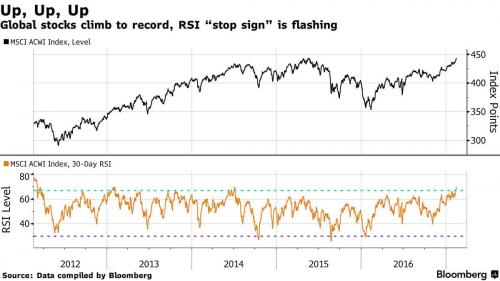Whether it is due to overnight news that much of the recent rally may have been due to one specific fund’s “gamma trap” and rapid cover of a synthetic “short SPY” trade, or just because algo traders have gotten a case of overbought robotic vertigo, S&P futures dropped 0.2% in early Thursday trading as risk appetite fizzled and European shares dropped on concern the longest rally since July 2015 went too far, while the yen, bonds and gold advanced as the dollar fell.
Europe’s Stoxx 600 declined, snapping a seven-day rally with Nestle SA dropping by the most this year after saying it will target lower growth. The dollar depreciated against G10 peers even as traders increased bets for higher U.S. interest rates following faster-than-expected U.S. inflation.
Despite the early weakness in US futures, world stocks hit an all time high on Thursday on renewed growth expectations and hopes that major economies like the United States will soon be serving up large helpings of fiscal stimulus: in this regard China has already done its share injecting a record $540 billion in credit last month. MSCI’s All Country World index, which spans 46 countries, notched the milestone as Wall Street hit its latest record and Asia and Europe consolidated the roughly 10 percent gains both have made since mid-December.
As showed on Valentine’s Day, global stocks have jumped in value to more than $70 trillion after Trump’s November victory. As further discussed, the 30-day relative strength index for the MSCI broadest measure of global equities crossed a level that indicates to some traders its due for a correction. The odds for a U.S. rate hike in March jumped to 42 percent from 30 percent two days ago.

“Following the sharp rally we’ve seen in cyclical shares since early November, investors are now getting reluctant to just buy whole sectors such as mining and banks, and are starting to pick the best stocks within the sectors,†Stephane Ekolo, chief European strategist at Market Securities, in London. “These stocks will prove more resilient when the selloff comes.†This despite strong economic data reports which showed surges in exports from Indonesia and Taiwan, falls in unemployment in Europe from Sweden to the Netherlands while stronger U.S. retail sales and inflation data on Wednesday came as Donald Trump again promised mass tax cuts.
Another reason for the upbeat mood has been that, unlike in recent years, the prospect of U.S. interest rate rises does not seem to be spooking markets. While monetary policy has taken a back seat to Trump’s fiscal promises, overnight Fed’s Dudley (Voter, Dove) stated the Fed would end bond reinvestments and reduce Fed portfolio when they are confident the economy can withstand it and added reducing the balance sheet could stretch out the rate hike path. Dudley also commented the economy is growing slightly above trend and that he expects Fed to raise rates gradually a little further in the months ahead if forecasts pans out.
The dollar is still down for the year despite a strong run over the last couple of weeks, while Treasury yields, have barely risen, which has helped propel emerging market bonds, stocks and many currencies higher. As Reuters notes, the dollar hit the brakes again on Thursday as the glow of the previous day’s upbeat data faded. U.S. government bond yields eased too, taking German Bunds and Europe’s other benchmarks with them. Upcoming elections in the Netherlands, France, Germany and possibly Italy, have kept investors interested in “safe” government bonds particularly with anti-euro and anti-EU sentiment on the increase throughout the continent.
Overnight oil prices recovered from a knock from data showing record high U.S. crude and gasoline inventories. Brent and U.S. crude both inched up 0.3 percent to $55.92 and $53.28 a barrel respectively, while gold prices also rose as the dollar drifted down. Industrial bellwether copper, which has surged 30 percent since late October, eased however to $6,028 a tonne after China’s overseas investment weakened. China is the world’s top copper user, but prices were supported by the prospect of supply disruptions in Chile and Indonesia.
The mildly weaker metals prices meant European shares couldn’t quite hold their ground either despite the sentiment boost from the new record high in global stocks. The STOXX 600 index was 0.3% lower by 1000 GMT – the first decline since Feb. 6, with only technology, healthcare and telecommunications shares eking out gains -but this year’s rally has been underpinned by the fact European company earnings are expected to grow 14% this year, according to Thomson Reuters I/B/E/S data.
Asia had no such problems overnight. MSCI’s main Asia index rose 0.2 percent to its highest since July 2015 after Wall Street had again pushed relentlessly into record-high territory. Chinese shares traded in Hong Kong continued a rally and the Hang Seng climbed to the highest since August 2015.The MSCI Asia Pacific Index added 0.5%, though more stocks fell than rose.
* * *
Overnight Bulletin Summary from RanSquawk
- European equities trade modestly lower this morning with energy the notable laggard, while defensive sectors such as healthcare outperform
- Further losses suffered in the major USD pairings, with reports of China selling 1yr CNH setting the flowtheme for the day
- Highlights include: US Jobless Claims, Philadelphia Fed Manufacturing Index, ECB Meeting Minutes and comments from ECB’s Coeure

